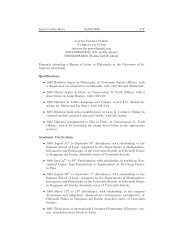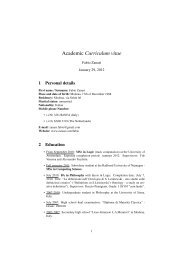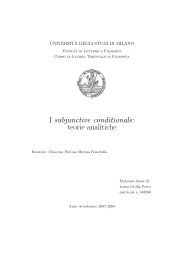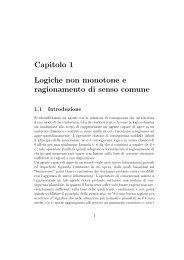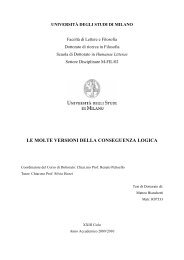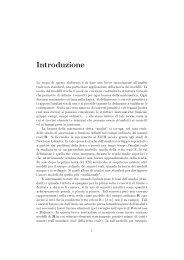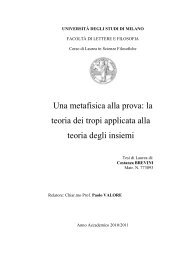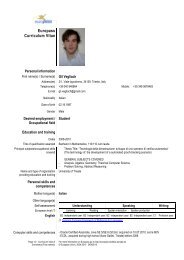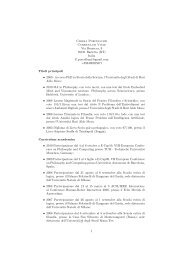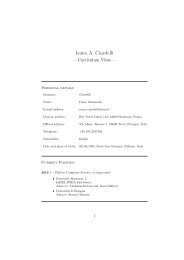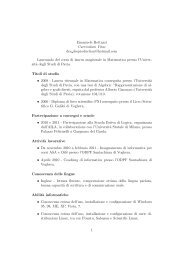Ω-Theory: Mathematics with Infinite and Infinitesimal Numbers - SELP
Ω-Theory: Mathematics with Infinite and Infinitesimal Numbers - SELP
Ω-Theory: Mathematics with Infinite and Infinitesimal Numbers - SELP
You also want an ePaper? Increase the reach of your titles
YUMPU automatically turns print PDFs into web optimized ePapers that Google loves.
CHAPTER 1. Ω-CALCULUS<br />
Proposition 1.1.5. An ordered field is Archimedean if <strong>and</strong> only if its only infinitesimal<br />
number is 0.<br />
Before we give the proof of this proposition, we recall that an ordered field is<br />
Archimedean if the following property holds:<br />
∀x > 0 ∀y > 0 ∃n ∈ N : ny > x<br />
or, in other words, the iterated sums of any positive element y surpass any given<br />
number x.<br />
Proof of Proposition 1.1.5. Let ξ be an infinitesimal number. Without loss of generality,<br />
we can suppose ξ > 0 (otherwise, choose −ξ). Since we have, by definition,<br />
ξ < 1/n for all n ∈ N, if we consider the inverses we have n < 1/ξ for all n ∈ N or,<br />
in other words, the field is not Archimedean.<br />
Now, suppose that the field is not Archimedean. Then, by definition, we have<br />
an element ξ that is a counterexample for the Archimedean property, that is n < ξ<br />
for all n ∈ N. Then 1/ξ is a nonzero infinitesimal number, since 0 < 1/ξ < 1/n for<br />
all n ∈ N.<br />
Proposition 1.1.5 gives a very interesting characterization of non-Archimedean<br />
fields, <strong>and</strong> shows that fields containing infinitesimal numbers don’t satisfy some<br />
common properties we are used to take for granted.<br />
1.2 Superreal Fields<br />
In the mathematical practice <strong>and</strong> especially in analysis, the most used extension of<br />
the real field is given by the complex numbers C. Instead, we want to concentrate<br />
on those extensions of R that are still ordered fields.<br />
Definition 1.2.1. A superreal field is an ordered field F that properly extends R<br />
(e.g. R ⊂ F, R + ⊂ F + , <strong>and</strong> the inclusions are strict).<br />
It turns out that any superreal field contains infinitesimal <strong>and</strong> infinite numbers,<br />
as shown in the next Theorem.<br />
Theorem 1.2.2. Any superreal field F is non-Archimedean.<br />
Proof. Thanks to Proposition 1.1.5, we only need to show that F contains an infinite<br />
or infinitesimal number. Choose ξ ∈ F\R. Without loss of generality, we can suppose<br />
ξ > 0. If ξ > n for all n ∈ N, there’s nothing to prove. Let’s suppose this is not the<br />
case, <strong>and</strong> 0 < ξ < n for some n ∈ N. Now, consider the set<br />
X = {x ∈ R : ξ < x}<br />
of the real upper bounds of ξ. By hypothesis, X is nonempty <strong>and</strong> bounded below.<br />
Using the completeness property of R, the element r = inf X is a well defined real<br />
number. We claim that ζ = ξ − r is an infinitesimal number.<br />
To prove our claim, let’s pick n ∈ N. By the properties of least upper bound, we<br />
have that ξ ≥ r − 1/n, so that ζ ≥ −1/n, <strong>and</strong> ξ < r + 1/n, so that ζ < 1/n. Since<br />
both inequalities hold for all n ∈ N, we conclude that ζ is a nonzero infinitesimal<br />
number.<br />
4




